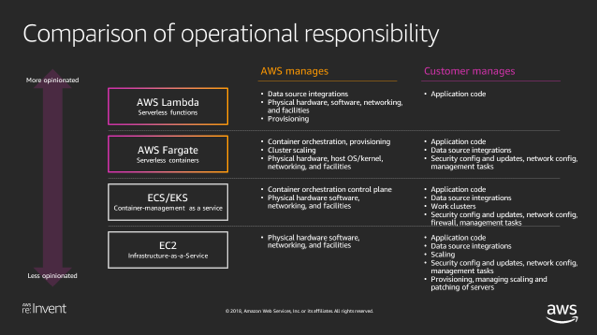Modern applications at AWS
 Innovation has always been part of the Amazon DNA, but about 20 years ago, we went through a radical transformation with the goal of making our iterative process—"invent, launch, reinvent, relaunch, start over, rinse, repeat, again and again"—even faster. The changes we made affected both how we built applications and how we organized our company.
Innovation has always been part of the Amazon DNA, but about 20 years ago, we went through a radical transformation with the goal of making our iterative process—"invent, launch, reinvent, relaunch, start over, rinse, repeat, again and again"—even faster. The changes we made affected both how we built applications and how we organized our company.Back then, we had only a small fraction of the number of customers that Amazon serves today. Still, we knew that if we wanted to expand the products and services we offered, we had to change the way we approached application architecture.
The giant, monolithic "bookstore" application and giant database that we used to power Amazon.com limited our speed and agility. Whenever we wanted to add a new feature or product for our customers, like video streaming, we had to edit and rewrite vast amounts of code on an application that we'd designed specifically for our first product—the bookstore. This was a long, unwieldy process requiring complicated coordination, and it limited our ability to innovate fast and at scale.
We created a blueprint for change with our "Distributed Computing Manifesto." This was an internal document describing a new architecture. With this manifesto, we began restructuring our application into smaller pieces called "services" that enabled us to scale Amazon dramatically.
But changing our application architecture was only half the story. Back in 1998, every Amazon development team worked on the same application, and every release of that application had to be coordinated across every team.
To support this new approach to architecture, we broke down our functional hierarchies and restructured our organization into small, autonomous teams, small enough that we could feed each team with only two pizzas. We focused each of these "two-pizza teams" on a specific product, service, or feature set, giving them more authority over a specific portion of the app. This turned our developers into product owners who could quickly make decisions that affected their individual products.
Breaking down our organization and application structures was a bold idea, but it worked. We were able to innovate for our customers at a much faster rate, and we've gone from deploying dozens of feature deployments each year to millions, as Amazon has grown. Perhaps more dramatically, our success in building highly scalable infrastructure ultimately led to the development of new core competencies and resulted in the founding of AWS in 2006.
Continue reading >>>
Comments
Post a Comment